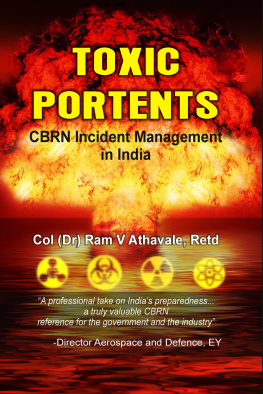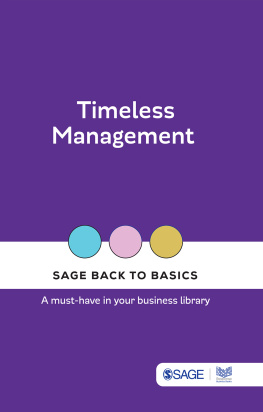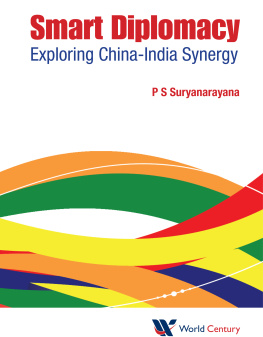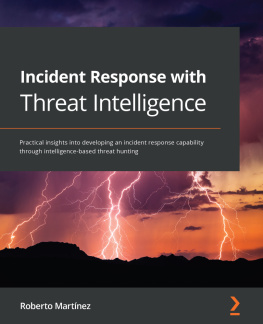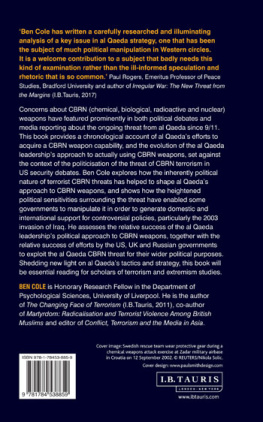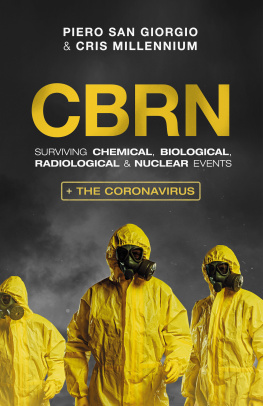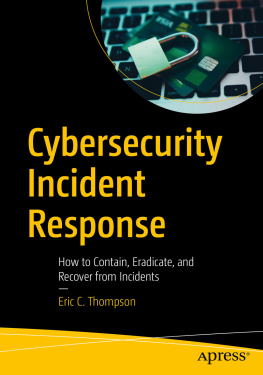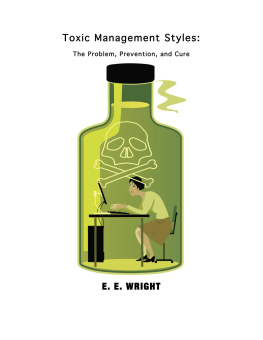Published by
Vij Books India Pvt Ltd
(Publishers, Distributors & Importers)
2/19, Ansari Road
Delhi 110 002
Phones: 91-11-43596460, 91-11-47340674
Fax: 91-11-47340674
e-mail:
web : www.vijbooks.com
Copyright 2019, Author
ISBN: 978-93-88161-82-4 (Hardback)
ISBN: 978-93-88161-83-1 (ebook)
All rights reserved.
No part of this book may be reproduced, stored in a retrieval system, transmitted
or utilized in any form or by any means, electronic, mechanical, photocopying,
recording or otherwise, without the prior permission of the copyright owner.
Application for such permission should be addressed to the publisher.
The views expressed in this book are of the author in his personal capacity.
Most countries of the world are prone to natural disasters and manmade emergencies whose intensity and frequency are on the increase owing to the climatic changes, widespread industrialization and advancing technologies. Though it is not exclusive for India or South-East Asia, yet this part of the world is comparatively more affected by such disasters/emergencies and results in loss of lives, infrastructure and livelihood of those affected.
The probabilities of Chemical, Biological, Radiological and Nuclear (CBRN) emergencies in India are also increasing due to rapid industrialization and India emerging as one of the biggest hubs of chemical industry. This has also enhanced transportation of chemical and radiological materials across the country which too is prone to public emergencies. This is due to rising chances of accidents at roads and lack of strict compliance of regulations on standards of transport containers etc., especially so in case of chemicals. Such shortcomings are very much visible during a number of incidents at Delhi, Bhopal and other parts of the country.
Number of biological threats like Swine Flu, Dengue, Bird Flu, malaria etc. is becoming common feature among Indians. High visibility events and large public congregations like religious gatherings, cultural extravaganzas, international games etc. are all highly vulnerable to CBRN emergencies either due to inadvertent presence of CBRN material at the site of the event or due to intentional use of such agents by unlawful elements. Efforts at different levels of Government Departments and other stakeholders like NGOs are ongoing to spread awareness among common public and official of Governments. These initiatives need to be further strengthened along with adoption of mitigation measures.
Disaster Management (DM) continued to be relief centric till the enactment of DM Act-2005 which resulted in a paradigm shift in the basic DM approach from relief centric to covering full cycle of DM i.e. prevention, mitigation, preparedness, response, relief and recovery including reconstruction and rehabilitation. This brought in whole lot of scientific inputs regarding hazards, risk, and vulnerability, not only on natural disasters but also CBRN, giving insights into Disaster Risk Reduction (DRR). To prepare a vast country like India in all these aspects including medical management of such events is a formidable task due to a large number of factors like, Government priorities, level of poverty, economy etc. In spite of these, Government of India has done and continues to do a lot in this critical area.
The above concepts in DM are becoming very popular among the DM experts, NGOs and various National and International agencies involved in these activities. However, these are yet to be easily comprehended by the common man. The Author of the book, Toxic Portents: CBRN Incident Management in India, Col Ram Athavale, is deeply involved in DM activities and has made a humble yet an excellent effort to put forth these concepts in common mans language so as to make these generate greater awareness and visibility towards CBRN risk mitigation.
We have come a long way in safety and security both at facility level and during transport of radiological and nuclear materials. The major role in this has been played by strictly enforcing of regulations that are at par with international regulations by a full fledged nuclear regulatory body, Atomic Energy Regulatory Board (AERB) and spreading of risk informed decision making and safety culture across nuclear establishment in India. But somehow constitution of such strict enforcing regulatory body in chemicals lacks even today in India though we have huge chemical industrial base. This has spread increasing complacency and indifference to life threatening activities and compromising on safety and security both in process and in handling and transport of toxic materials in the urge for greater production and faster outputs. This is reflected in day to day chemical accidents both within plants and in the public domain. In this backdrop, the book comes across like a loud wakeup call to all stakeholders, public and private.
The book covers evolvement of CBRN incident management in India and reflects purely his own views. It deals with CBRN governance, legal provisions, nodal structure and response mechanism including community participation. The authors thoughts on critical infrastructure and high visibility event CBRN security and the factors that will lead to effective CBRN resilience have been very clearly explained. The mention of societal CBRN security and developing a CBRN security culture is an area of interest to enhance societal awareness. The book also explains use of advanced technologies for effective CBRN risk mitigation and other related issues.
The book Toxic Portents: CBRN Incident Management in India is a must read for all relevant ministries, stakeholder agencies, private hazmat management bodies, NGOs and social institutions dealing with CBRN matters. The sequential chapterisation and handling of each topic shows the in-depth study that has been done by Col Ram Athavale while writing the book. I have no doubt that the book will find place as a Reference book in the libraries of all training establishments, strategic and security Think Tanks and Universities who need to make full use of this book. Hospitals, research establishments, paramedical services, CBRN industries and even social bodies should draw from this book to raise and enhance CBRN awareness among their staff and teams.
I am glad the Author has brought out his wide experience and knowledge in this area. I am confident that this will immensely serve to raise the awareness among the common man and will equally be beneficial to the students and professionals who plan to work in the important area of CBRN DM and risk mitigation. My compliments to Col Ram Athavale.
Dr. D.N. Sharma
Member,
National Disaster Management Authority
The world today is plagued by many man-made threats. Gone is the pristine environment of yesteryears. What we see are concrete jungles, artificially grown food, cloud seeded toxic rains, dried up rivers, heat and poison belching industries, melting snows, fast denuding natural resources, burgeoning waste and a plasticised world with no fresh air to breathe. Add to this the spectre of global terrorism. Researchers, administrators and concerned global citizens are striving hard to prevent and reverse the toxic tide.




